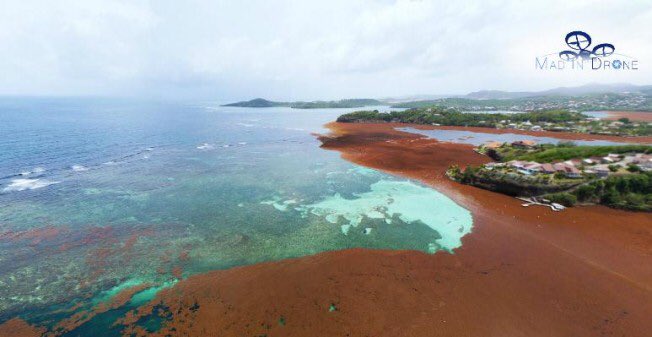Mystery seaweed threatens French Caribbean


During a trip to the French overseas territory Guadeloupe on Friday, President Emmanuel Macron pledged to keep a promise to clean up toxic Sargassum seaweed within 48 hours of it running aground.
Like the rest of the Caribbean, the Antilles suffered in 2011 from an unprecedented invasion of Sargassum seaweed (sometimes known as gulf weed). The problem recurred in 2015 and then on an even larger scale in 2018. The brown seaweed poses potential health risks. The mounds of Sargassum that accumulate on the beach can reach as high as two feet and release hydrogen sulfide and ammonia as it rots.
The colourless, toxic and highly flammable gas smells like rotten eggs. Inhaling it in small doses can trigger eye and respiratory irritation.
Former French minister for the environment Nicolas Hulot presented a €10 million plan in June to help combat the problem. His subsequent resignation set off a flurry of panic in the islands over whether the government would renege on its pledge to help with the problem.
“It’s a catastrophe,” said Christian Baptiste, the mayor of Saint-Anne in Guadeloupe, where a crèche was shut down in June over sanitation fears for the young children. A secondary school also closed for four days due to the bloom.
In Guadeloupe on Friday, Macron reassured residents that he was committed to addressing the problem, saying “the best way to protect everyone is to pick it up as quickly as possible, within 48 hours after it washes ashore or even before it runs ashore, to prevent any damage or sanitary problems.”
In Goyave, one of the first communes in Guadeloupe to sign a convention for managing Sargassum, he said that the state would “co-finance” the project with €4-5 million over 2018 and 2019, and would contribute €500,000 to the acquisition of collection barges.
In Martinique and Guadeloupe, locals have struggled to deal with the problem. People feel powerless and angry.
“It’s unbearable. Since March, it has been washing up regularly,” said Elmire Joseph, a resident of the town of Goyave, a few hundred metres from the sea. His daughter Meggy Adonaï says she has regular eye allergies.
In Martinique, residents of the Robert neighborhood on the Atlantic coast mobilised before Macron’s arrival to block part of the road with home appliances corroded and rendered useless by the gases released by the seaweed.
The president announced that he was working with the French Federation for Insurance Agencies to come up with a plan to reimburse damages. “We will do what it takes to amend contracts to take into account the new risks in overseas territories,” he said.
Finally, he called for research to identify the causes of the problem and ways to manage it.
Threatening an ecosystem
Saragassum has historically proliferated only in the Saragasso Sea, a region in the northern Atlantic. As it has drifted into the Caribbean in large quantities, it has begun to pose serious ecological concerns. It blocks light from light-dependent organisms such aa sea grass and corals. It attracts insects and crabs, trapping sea turtles, killing dolphins and scaring off beachgoers.
As the rafts of Sargassum drift from the Caribbean northward, they bring organisms from distant places and introduce them into foreign habitats. The invasion can be dangerous for local fish and bottom-dwelling flora and fauna, says Lew Gramer, a scientist at the University of Miami Rosenstiel School Cooperative Institute for Marine and Atmospheric Studies.
But there is no consensus about what is causing the phenomenon, which has effected much of the Caribbean and the southern Atlantic coast of the US.
“We are in the infancy of knowledge about Sargassum. We need to fill in the gaps,” says Jean Blanchot, tropical oceanographer. Two scientific expeditions were conducted in 2017 to unravel the mystery of these invasions since 2011. But they didn’t reveal why the Sargassum has left the Sargasso Sea.
There are two popular hypotheses: more maritime traffic in the Caribbean and deforestation in the Amazon. “The actions of humans on the planet are more and more significant. We are disturbing the Saragasso Sea with big ships,” says Blanchot. There’s also agriculture, which is “developing in places where there was no agriculture before. So big rivers like the Amazon are filled with nutrients that can, once they reach the ocean, feed algae.”
Further research, he says, should focus on developing predictive models for seaweed dispersion on the ocean surface.
Other researchers have sought to identify practical uses for the seaweed, but with little success.
“We know a lot has been said of using the Sargassum as fertilizer but at this point there is no feasible option without government support to tackle the issue. We need to find a way to coordinate the removal of the seaweed with heavy loaders which causes serious risks to nesting sea turtles and hatchlings while the grass itself can be a hazard to the animals,” said St. Martin Nature Foundation manager Tadzio Bervoets.
US Companies sought to harvest the seaweed for fertilizer, but the Federal government outlawed it because the seaweed provides habitat for fish. There is also evidence that the beached Sargassum can stabilise beach sand as it decomposes.
(FRANCE 24 and REUTERS)
IMAGE:© Helene Valenzuela, AFP | A picture taken on April 23, 2018 shows sargassum seaweed (sargasso) on the Salines beach in the city of Le Gosier on the French Caribbean Island of Guadeloupe.
For more on this story go to: https://www.france24.com/en/20180929-france-macron-seaweed-guadeloupe-hulot








